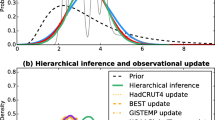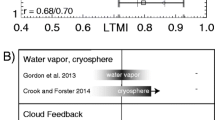Abstract
Credible climate predictions require a rational quantification of uncertainty, but full Bayesian calibration requires detailed estimates of prior probability distributions and covariances, which are difficult to obtain in practice. We describe a simplified procedure, termed precalibration, which provides an approximate quantification of uncertainty in climate prediction, and requires only that uncontroversially implausible values of certain inputs and outputs are identified. The method is applied to intermediate-complexity model simulations of the Atlantic meridional overturning circulation (AMOC) and confirms the existence of a cliff-edge catastrophe in freshwater-forcing input space. When uncertainty in 14 further parameters is taken into account, an implausible, AMOC-off, region remains as a robust feature of the model dynamics, but its location is found to depend strongly on values of the other parameters.






Similar content being viewed by others
References
Beltran C, Edwards NR, Haurie A, Vial J-P, Zachary DS (2006) Oracle-based optimization applied to climate model calibration. Environ Model Assess 11:31–43
Challenor PG, Hankin RKS, Marsh R (2006) Towards the probability of rapid cimate change. In: Schellnhuber HJ, Cramer W, Nakicenovic N, Wigley T, Yohe G (eds) Avoiding dangerous climate change. Cambridge University Press, Cambridge, pp 53–63
Chaloner K, Verdinelli I (1995) Bayesian experimental design: a review. Stat Sci 10(3):273–304
Craig PS, Goldstein M, Seheult AH, Smith JA (1997) Pressure matching for hydrocarbon reservoirs: A case study in the use of Bayes Linear strategies for large computer experiments. In: Gatsonis C, Hodges JS, Kass RE, McCulloch R, Rossi P, Singpurwalla ND (eds) Case studies in Bayesian Statistics III. Springer, New York, pp 37–87 (With discussion)
Craig PS, Goldstein M, Rougier JC, Seheult AH (2001) Bayesian forecasting for complex systems using computer simulators. J Am Stat Assoc 96:717–729
Draper NR, Smith H (1998) Applied regression analysis, 3rd edn. Wiley, New York
Edwards NR, Marsh R (2005) Uncertainties due to transport-parameter sensitivity in an efficient 3-D ocean-climate model. Clim Dyn 24:415–433
Goldstein M, Rougier JC (2004) Probabilistic formulations for transferring inferences from mathematical models to physical systems. SIAM J Sci Comput 26(2):467–487
Goldstein M, Rougier JC (2006) Bayes linear calibrated prediction for complex systems. J Am Stat Assoc 101:1132–1143
Goldstein M, Rougier JC (2009) Reified Bayesian modelling and inference for physical systems. J Stat Plan Inference 139:1221–1239 (With discussion)
Gregory JM, Dixon KW, Stouffer RJ, Weaver AJ, Driesschaert E, Eby M, Fichefet T, Hasumi H, Hu A, Jungclaus JH, Kamenkovich IV, Levermann A, Montoya M, Murakami S, Nawrath S, Oka A, Sokolov AP, Thorpe RB (2005) A model intercomparison of changes in the Atlantic thermohaline circulation in response to increasing atmospheric CO2 concentration. Geophys Res Lett 32, Art. No. L12703. doi:10.1029/2005GL023209
Hargreaves JC, Annan JD, Edwards NR, Marsh R (2004) Climate forecasting using an intermediate complexity Earth System Model and the Ensemble Kalman Filter. Clim Dyn 23:745–760
Holden PB, Edwards NR, Oliver KIC, Lenton TM, Wilkinson RD (2009) A probabilistic calibration of climate sensitivity and terrestrial carbon change in GENIE-1. Clim Dyn. doi:10.1007/s00382-009-0630-8
Koehler JR, Owen AB (1996) Computer experiments. In: Ghosh S, Rao CR (eds) Handbook of statistics, 13: design and analysis of experiments. Elsevier Science B.V., North-Holland, pp 261–308
Kynn M (2008) The ‘heuristics and biases’ bias in expert elicitation. J R Stat Soc A 171:239–264
Lenton TM, Marsh R, Price AR, Lunt DJ, Aksenov Y, Annan JD, Cooper-Chadwick T, Cox SJ, Edwards NR, Goswami S, Hargreaves JC, Harris PP, Jiao Z, Livina VN, Payne AJ, Rutt IC, Shepherd JG, Valdes PJ, Williams G, Williamson MS, Yool A (2007) Effects of atmospheric dynamics and ocean resolution on bi-stability of the thermohaline circulation examined using the Grid ENabled Integrated Earth system modelling (GENIE) framework. Clim Dyn 29:591–613
Marsh R, Yool A, Lenton TM, Gulamali MY, Edwards NR, Shepherd JG, Krznaric M, Newhouse S, Cox SJ (2004) Bistability of the thermohaline circulation identified through comprehensive 2-parameter sweeps of an efficient climate model. Clim Dyn 23:761–777
Meehl GA et al (2007) Global climate projections. In: Solomon S et al (eds) Climate change 2007: the physical science basis. Contribution of working group 1 to the fourth assessment report of the intergovernmental panel on climate change. Cambridge University Press, Cambridge, pp 747–845
Murphy JM, Sexton DMH, Barnett DN, Jones GS, Webb MJ, Collins M, Stainforth DA (2004) Quantification of modelling uncertainties in a large ensemble of climate change simulations. Nature 430:768–772
Murphy JM, Booth BBB, Collins M, Harris GR, Sexton DMH, Webb MJ (2007) A methodology for probabilistic predictions of regional climate change from perturbed physics ensembles. Philos Trans R Soc Lond A 365:1993–2028
O’Hagan A (2006) Bayesian analysis of computer code outputs: a tutorial. Reliab Eng Syst Saf 91:1290–1300
Price AR, Voutchkov II, Pound GE, Edwards NR, Lenton TM, Cox SJ, the GENIE team (2006) Multiobjective tuning of Grid-enabled Earth System Models using a non-dominated Sorting Genetic Algorithm (NSGA-II). In: Proceedings of the 2nd international conference on eScience and grid computing, Amsterdam, Netherlands
R Development Core Team (2004) R: a language and environment for statistical computing. R Foundation for Statistical Computing, Vienna, Austria. ISBN 3-900051-00-3. http://www.R-project.org/
Rougier JC (2007) Probabilistic inference for future climate using an ensemble of climate model evaluations. Clim Change 81:247–264
Rougier JC (2008) Efficient emulators for multivariate deterministic functions. J Comput Graph Stat 17(4):827–843
Rougier JC, Sexton DMH (2007) Inference in ensemble experiments. Philos Trans R Soc Lond A 365:2133–2143
Rougier JC, Sexton DMH, Murphy JM, Stainforth D (2009) Analysing the climate sensitivity of the HadSM3 climate model using ensembles from different but related experiments. J Clim 22(13):3540–3557. doi:10.1175/2008JCLI2533.1
Santner TJ, Williams BJ, Notz WI (2003) The design and analysis of computer experiments. Springer, New York
Schmittner A, Latif M, Schneider B (2005) Model projections of the North Atlantic thermohaline circulation for the 21st century assessed by observations. Geophys Res Lett 32 Art. No. L23710
Stouffer RJ, Yin J, Gregory JM, Dixon KW, Spelman MJ, Hurlin W, Weaver AJ, Eby M, Flato GM, Hasumi H, Hu A, Jungclaus JH, Kamenkovich IV, Levermann A, Montoya M, Murakami S, Nawrath S, Oka A, Peltier WR, Robitaille DY, Sokolov A, Vettoretti G, Weber SL (2006) Investigating the causes of the response of the thermohaline circulation to past and future climate changes. J Clim 19:1365–1387
Vellinga M, Wood RA (2002) Global climatic impacts of a collapse of the Atlantic thermohaline circulation. Clim Change 54:251–267
Vellinga M, Wood RA (2008) Impacts of thermohaline circulation shutdown in the twenty-first century. Clim Change 91:43–63
Venables WN, Ripley BD (2002) Modern applied statistics with S, fourth edition. Springer-Verlag, New York
Würtz D (2007) High dimensional scrambled sobol sequences: an R and Splus software implementation. Unpublished. http://www.itp.phys.ethz.ch/econophysics/R/pdf/JSS-Sobol.pdf, and as part of the fOptions package
Zickfeld K, Levermann A, Granger Morgan M, Kuhlbrodt T, Rahmstorff S, Keith DW (2007) Expert judgements on the response of the Atlantic meridional overturning circulation to climate change. Clim Change 82:235–265
Acknowledgments
The authors gratefully acknowledge the help of Andrew Price in performing large ensemble simulations, as well as support from the UK Natural Environment Research Council (NERC) RAPID climate change programme (via the THCMIP project), the NERC QUEST programme and the UK Department for Environment, Food and Rural Affairs (via the UK Met Office). Part of this work was completed while Rougier was a Duke University Fellow at the Statistical and Applied Mathematical Sciences Institute (SAMSI), Durham NC.
Author information
Authors and Affiliations
Corresponding author
Rights and permissions
About this article
Cite this article
Edwards, N.R., Cameron, D. & Rougier, J. Precalibrating an intermediate complexity climate model. Clim Dyn 37, 1469–1482 (2011). https://doi.org/10.1007/s00382-010-0921-0
Received:
Accepted:
Published:
Issue Date:
DOI: https://doi.org/10.1007/s00382-010-0921-0




